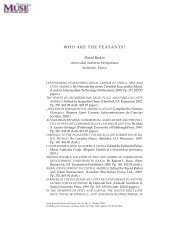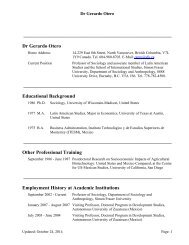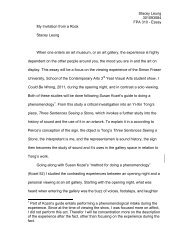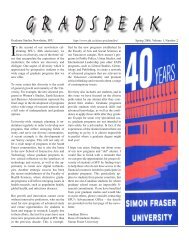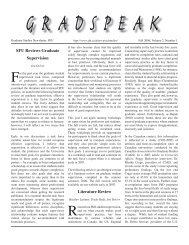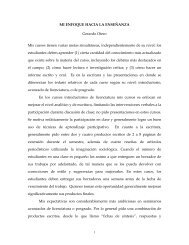Link - Simon Fraser University
Link - Simon Fraser University
Link - Simon Fraser University
Create successful ePaper yourself
Turn your PDF publications into a flip-book with our unique Google optimized e-Paper software.
646 M. W. Hart and P. B. Markoassumptions has been widely criticized for lackingbiological realism in many natural situations, andviolation of these assumptions can potentially severelybias estimates of migration from F ST (Burtonand Feldman 1982; Bossart and Prowell 1998;Cunningham and Collins 1998; Waples 1998; Beerliand Felsenstein 1999, 2001; Whitlock and McCauley1999; Neigel 2002). The equilibrium assumption, forexample, is probably wrong for many species in temperateregions that have undergone large polewardrange extensions and massive demographic expansionssince the end of the last glacial maximum10,000 years ago. The time required (in generations)for F ST to reach equilibrium may be muchgreater than this, depending on migration rates andeffective population sizes (Crow and Aoki 1984;Whitlock 1992; Whitlock and McCauley 1999). Theimpact of violating this assumption depends on thehistory of isolation between populations; estimates ofmigration between populations will be biasedupward if populations have very recently separatedbut will be biased downwards if populations havenewly come into contact. Comparative studies thatattempt to use F ST -based methods such as analysis ofmolecular variance (AMOVA; Excoffier et al. 2005)to account for phylogeographic differences amongmarine species in terms of mode of larval developmentand rate of gene flow are thus potentially confoundedby violations of the equilibrium assumptiongiven that the approach to equilibrium depends primarilyon effective population size, rates of geneflow, and metapopulation dynamics (population divergencetimes), all factors expected to differ amongspecies with different modes of development.Although all of the variants of F ST remain usefulways to summarize patterns of population differentiation(Bohonak 1999; Whitlock and McCauley1999; Neigel 2002), estimates of migration fromnew analytical methods, largely those based uponneutral coalescent theory, have slowly been incorporatedinto marine phylogeographic studies becausethese newer methods have several desirable features(Kuhner 2009). Arguably the most important improvementin these methods is that they providejoint estimates of the population genetic parametersthat collectively produce spatial patterns of differentiation,especially effective population size, migration,population growth rates, and divergence time. Thisapproach is generally superior because it avoids posthoc interpretation of spatial patterns (i.e., F ST ) interms of unobserved demographic processes (i.e.,asymmetrical gene flow, ancient vicariance, recentrange extension, population expansion, or bottlenecks),and instead directly estimates parametersassociated with those demographic processes. LikeF ST -based approaches, both the precision and accuracyof coalescent estimates of these populationparameters are greatly improved by (or even criticallydependent on) combined analysis of multiple loci insingle datasets that use information from the variancein coalescent times across loci (Edwards andBeerli 2000).For datasets with multiple loci, this coalescent approachhas mainly been implemented using one ofthree methods implemented in user-friendly softwarepackages running on fast publicly-accessible computerclusters: MIGRATE-N, LAMARC, and IMA (andthe earlier related programs IM and MDIV). All ofthese methods provide maximum likelihood estimatesof population genetic parameters across agroup of likely gene trees simulated with MarkovChain Monte Carlo (MCMC) sampling of genealogies,and are thus dubbed ‘‘coalescent samplers’’(Kuhner 2009). Using a random gene-tree topologyas a starting point, MCMC methods repeatedly makesmall arbitrary topological changes, and assess thelikelihood of the resulting genealogy at each stepwithin a model of neutral coalescence backwards intime. Highly likely gene trees are retained and populationgenetic parameters are estimated across theentire sample of trees. Parameter estimation across alarge sampling of trees (rather than from a single‘‘best’’ tree) is important, given the high degreeof uncertainty in gene-tree topologies within singlespecies or between closely related species. MCMCsampling can be guided by either a likelihood orBayesian approach in MIGRATE-N and LAMARC, butonly a Bayesian framework is available with IMA.The main differences among these methods (andthat pertain most to our review) are the populationparameters that each method estimates, and thuswhat each method does and does not assumeabout the history of the population. All three methodsestimate the population genetic parameter andseparate migration rates (M ¼ N e m, where N e is theeffective population size and m is the probability ofmovement by an individual from one population tothe other per generation) between populations inboth directions (bidirectional migration). The parameter, equivalent to 4N e m (where m is the mutationrate), is essentially a proxy for relativepopulation size given that mutation rates can reasonablybe assumed to be equal among populationswithin a single species. Both MIGRATE-N andLAMARC make these estimates for a group of npopulations but IMA is limited to the analysis of asingle pair of populations. MIGRATE-N and LAMARCcan accommodate multiple populations becauseDownloaded from icb.oxfordjournals.org at <strong>Simon</strong> <strong>Fraser</strong> <strong>University</strong> on November 2, 2010



